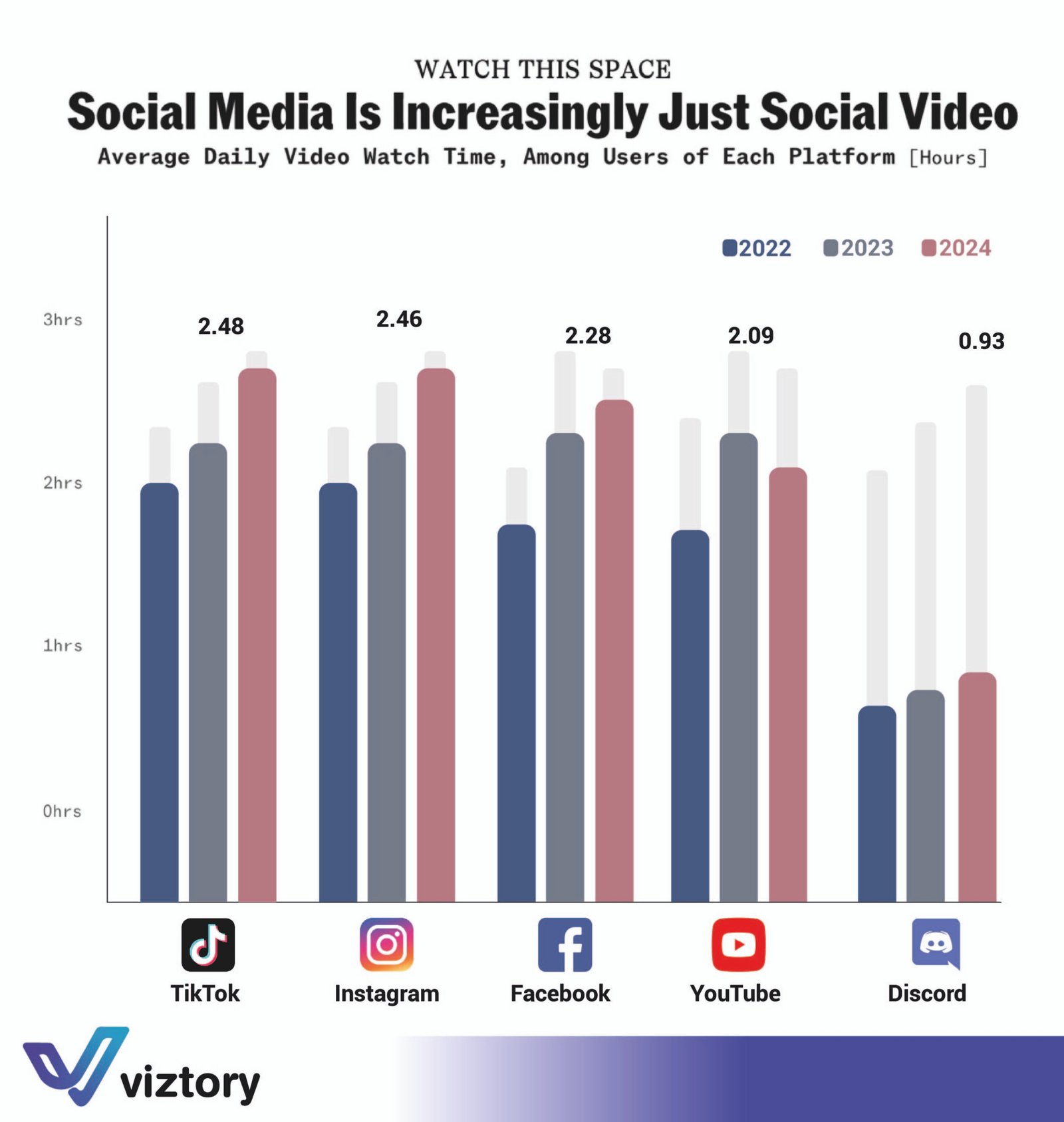The Evolution of Social Media: How Video Content Dominates in 2024
-
Aug, Sat, 2024
The Evolution of Social Media: How Video Content Dominates in 2024
In recent years, social media has undergone a significant transformation, increasingly pivoting towards video content. The latest statistics for 2024 highlight this trend, showing the average daily video watch time among users of various platforms. This shift is deeply intertwined with advancements in technology, reflecting how digital innovation shapes user behavior and platform strategies.
Average Daily Video Watch Time by Platform
TikTok
- 2022: ~2.3 hours
- 2023: ~2.4 hours
- 2024: 2.48 hours
Instagram
- 2022: ~2.1 hours
- 2023: ~2.2 hours
- 2024: 2.46 hours
Facebook
- 2022: ~1.8 hours
- 2023: ~2.0 hours
- 2024: 2.28 hours
YouTube
- 2022: ~1.9 hours
- 2023: ~2.0 hours
- 2024: 2.09 hours
Discord
- 2022: ~0.8 hours
- 2023: ~0.85 hours
- 2024: 0.93 hours
The Technological Factors Driving the Shift
Advancements in Mobile Technology
The widespread adoption of smartphones with high-resolution screens and powerful processors has made video consumption more accessible and enjoyable. Platforms like TikTok and Instagram have capitalized on this by optimizing their apps for mobile use, encouraging users to spend more time watching video content.
High-Speed Internet and 5G
The rollout of high-speed internet and 5G networks has significantly reduced buffering times and improved video quality. This technological leap has made streaming video content smoother and more reliable, contributing to increased video watch times across all platforms.
AI and Machine Learning Algorithms
Social media platforms are leveraging AI and machine learning to enhance user experiences. These technologies analyze user preferences and behaviors to deliver personalized video content, keeping users engaged for longer periods. TikTok’s algorithm, for example, is renowned for its ability to curate highly relevant and entertaining content, driving up watch times.
Content Creation Tools
The availability of advanced content creation tools has democratized video production, allowing users to create and share high-quality videos with ease. Features like Instagram Reels and Facebook Stories have empowered users to produce engaging video content, further fueling the video-centric trend.
Impact on Social Media Platforms
Platform Strategies and Features
Social media platforms are increasingly integrating video-centric features to cater to evolving user preferences. Instagram’s transition from a photo-sharing app to a video content hub and Facebook’s emphasis on video content through Watch and Stories are prime examples of how platforms are adapting to this trend.
User Engagement and Retention
Video content has proven to be more engaging than text or image-based posts. Platforms that prioritize video are seeing higher user engagement and retention rates. YouTube’s focus on video has made it a dominant player in the social media space, while platforms like Discord are gradually incorporating more video features to keep up with user demands.
Advertising and Revenue Models
The shift towards video content has also transformed advertising strategies. Video ads tend to be more impactful and generate higher engagement rates compared to traditional static ads. As a result, social media platforms are investing heavily in video advertising solutions, which is reflected in their revenue growth.
Conclusion
The 2024 statistics on average daily video watch time highlight the profound impact of technology on social media usage. Advancements in mobile technology, high-speed internet, AI, and content creation tools have collectively driven the shift towards video content. This evolution not only influences how platforms operate but also reshapes user engagement and advertising strategies. As technology continues to advance, the dominance of video content on social media is likely to grow, further cementing its role in the digital landscape.

